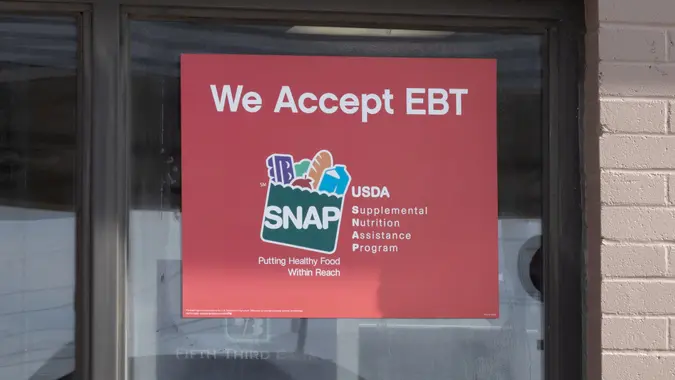What a Harris Presidency Could Mean for Paid Family Leave

Commitment to Our Readers
GOBankingRates' editorial team is committed to bringing you unbiased reviews and information. We use data-driven methodologies to evaluate financial products and services - our reviews and ratings are not influenced by advertisers. You can read more about our editorial guidelines and our products and services review methodology.

20 Years
Helping You Live Richer

Reviewed
by Experts

Trusted by
Millions of Readers
Traditionally, the United States has fallen woefully short of other countries when it comes to providing paid family leave. Many countries offer 100% paid family leave, with some offering it for a substantial amount of time. For example, Norway offers 49 weeks of leave with 100% pay. The United States, on the other hand, offers no paid leave.
While some states have taken the matter into their own hands, passing legislation to protect new parents wanting to bond with their children and families with a seriously ill loved one, the federal government offers no such protections. Under the Family and Medical Leave Act (FMLA), a covered employee in the U.S. is only guaranteed up to 12 weeks of unpaid, job-protected leave per year. Covered employers under the FMLA generally include those with 50 employees or more.
However, a Harris presidency may bring substantial changes to this policy. Here is what might happen for paid family leave if Vice President Kamala Harris is elected in November.
What Vice President Kamala Harris Has Said About Paid Family Leave
Harris has repeatedly said on the campaign trail that, if elected, she sees a future with paid leave. This is not a novel concept. Long before she was selected as the Democratic nominee, she advocated for Americans to receive pay to take care of their loved ones, whether it be when welcoming a new child into the family or taking care of a sick family member.
As a 2020 Democratic presidential candidate, Harris proposed her “Children’s Agenda,” which would allow for up to six months of paid family and medical leave for workers in the U.S. In a speech marking the 30th anniversary of the Family and Medical Leave Act, Harris argued for building on the legislation, which, although was a step in the right direction, fails to offer paid leave for American workers. Today, she has made it a central issue of her campaign.
What Tim Walz Has Done as Governor
It should come as no surprise that her choice of running mate has also been a staunch advocate of paid leave. As governor, Tim Walz signed a bill that would provide paid family and medical leave for workers in Minnesota.
According to a press release, Walz said, “Paid family and medical leave is about investing in the people that made our state and economy strong in the first place.”
The bill provides partial wage replacement for up to 20 weeks of family or medical leave during a 52-week period.
How a Harris-Walz Administration May Help Working Parents
Paid leave has been a centerpiece of the Harris-Walz campaign. As reported by Glamour, Walz answered that this should be the first thing Democrats pass if they run the table in November. A few days later, the governor of Minnesota was introduced as Kamala Harris’s running mate.
Together, the duo has made it no secret that paid family leave would be a central component of their White House. On the campaign trail, many of their speeches have echoed what they have previously said about wanting the federal government to act on providing paid leave.
In addition to paid leave, her newly unveiled economic plan calls for an expanded child tax credit and up to $6,000 for low- to middle-income families who welcome a new baby.
How Would Paid Leave Be Passed
According to the U.S. Department of Labor, 13 states and the District of Columbia have paid leave for qualified workers. Harris is calling for the federal government to ensure that workers across the country, regardless of their state, have access to this kind of benefit.
If elected, Harris might face something her predecessors did not: bipartisan support. Over the past year, a House paid leave working group consisting of members of both parties has been working on a framework for lawmakers to act on. With the idea gaining more bipartisan support, it appears that a path to paid family leave may be in the near future.
Editor’s note on election coverage: GOBankingRates is nonpartisan and strives to cover all aspects of the economy objectively and present balanced reports on politically focused finance stories. You can find more coverage of this topic on GOBankingRates.com.
More From GOBankingRates
 Written by
Written by  Edited by
Edited by 

























